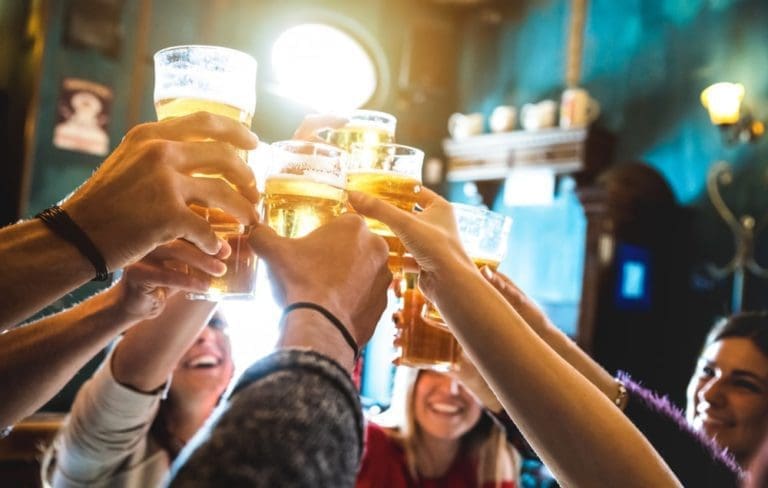
October 26, 2018
History of Happy Hour: An Insider Look into This Post-Work Tradition
“Hey, want to grab drinks after work?”
You’ve probably heard this phrase for most of your adult life – and who are you to refuse? Enjoying a summer evening on the patio with a drink in hand, or curling up in a cozy dive bar during the cold winter months with a hot toddy after a hard day of work – happy hour can be a true delight.
It’s great to unwind with a glass of wine or two, or even some sake if you’re feeling a bit adventurous, and we all need to take a load off after work sometimes. And whether you’re visiting with a coworker about their family, griping about your boss, or just trying to de-stress after a huge presentation, happy hour is the place to do it – and it makes your post-work drinking a bit easier on your wallet.
But how did happy hour get started? How did post-work drinks and “happy hours” become part of our everyday culture? It’s something that you probably don’t think about that much – but we’ve got the answers below. Keep reading, and find out how the Prohibition-era ban on alcohol turned into the post-work extravaganza that we all know and love.
Naval Beginnings
You can thank our nation’s sailors for laying the groundwork for happy hour as we know it. Without these rough, tattooed, and none-too-friendly men, we would lack the term entirely – as “Happy Hour” first was used in the early 1900s in the Navy.
This is because there were scheduled times to drink and socialize in Navy boats – which makes sense. You wouldn’t want your captain to start boozing at 10:00PM if he had the midnight shift!
Appropriately, this time began to be referred to as “happy hour”, due to the magical ability of a bit of booze to plaster a smile across just about anyone’s face – even a stern sailor!
Unfortunately, these first “happy hours” were busted by the year 1914, and banned. But happy hour lives on – so be proud of us, sailors of days past!
Speakeasies Take Control
Alas, the idea of banning alcohol altogether did not die with that Navy proclamation. The temperance movement was strong by the mid-1910s, and by 1920, the Volstead Act had banned the sale and consumption of alcohol everywhere throughout America. This is the time period we typically refer to as “Prohibition”.
But what else are the 20s known for? Speakeasies. If you’ve seen or read “Gatsby”, or ever dipped into any literature about the “Roaring Twenties”, you’ll know that wild parties and secret “speakeasies” (hidden bars that were typically ignored by authorities) were in their heydey!
If you were a determined drinker, Prohibition did next-to-nothing to stop you from drinking – which is one of the reasons it was eventually repealed.
And we also have speakeasies to thank for the modern happy hour. Many speakeasies and restaurants would have certain times before they started serving dinner, when they would secretly serve alcohol to customers, illegally.
These were called “happy hours” by drinkers, and they were eerily similar to the happy hours that we have today – a designated period of time when a dining establishment serves drinks (for a lower price) before dinner.
Normalized Casual Drinking
Once the Volstead Act was repealed in 1933, and the Prohibition era had left us, casual drinking became acceptable again – slowly, but surely. It peaked in the 50s, 60s, and 70s.
During these times – especially during the energy crisis and recession in the mid-1970s – there was a desire to maintain frugality, and still maintain a certain laid-back, “lounge” lifestyle. This spurred the creation of restaurant happy hours.
For patrons, this had the benefit of allowing them to enjoy post-work and pre-dinner drinks for a lower price. For restaurants, it brought in more customers, who would usually lounge and drink, and stay for dinner. And because the restaurant could choose their specials, they could pick cocktails and drinks that wouldn’t have a big impact on their finances – so they can stay profitable. We call that a win-win!
Happy Hour in Trouble?
Once the 1980s hit, however, happy hours began facing new restrictions.
Massachusetts, in an attempt to curb excessive drinking and stop alcohol-related crimes like public intoxication and drunk driving, banned happy hour altogether during this time period – and many are still trying to repeal this legislation, even today. This is despite the fact that happy hour bans show no impact on the prevalence of crimes like drunk driving.
Today, a total of 12 states including Utah, Vermont, Oklahoma, Indiana, and North Carolina have bans on happy hour, and a total of 32 others have strict regulations related to this workplace staple.
So drink up while you can, folks. While we don’t anticipate any kind of Prohibition-era restrictions on post-work drinks (we’d expect riots in the streets, if we did!) happy hour could be in a bit of trouble. It remains to be seen if this trend will reverse – or if more states will start controlling happy hours more tightly.
Origins of Happy Hour: Wrapping Up
Happy hour is a fun time that signals the end of a tough work day and the start of your time to relax and unwind. It’s a great time to connect with coworkers and bond with colleagues, and to visit with friends and other acquaintances who may work nearby, and don’t have time for dinner or another visit.
But all these bans and regulations might make it hard if you’re wondering, “where is a happy hour near me?”
The good news for you is that all of our restaurants offer happy hour. Contact us today to find a location closest to you.
